Furazolidone
Synonym(s):3-(5-Nitrofurfurylideneamino)-2-oxazolidinone;Furazolidone
- CAS NO.:67-45-8
- Empirical Formula: C8H7N3O5
- Molecular Weight: 225.16
- MDL number: MFCD00010550
- EINECS: 200-653-3
- SAFETY DATA SHEET (SDS)
- Update Date: 2025-12-11 08:41:34
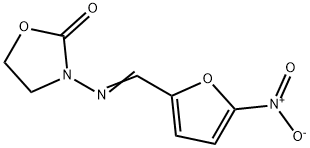
What is Furazolidone?
Description
Furazolidone belongs to the group of nitro furans. This antimicrobal (antibacterial and antiprotozoal) agent is used in veterinary medicine both topically and orally, particularly in animal feed. Reactions have been reported in workers exposed to it by contact with animal feed. Cross reactions with other nitrofuran derivatives are rare.
Chemical properties
solid
Originator
Tricofuron,Norwich Eaton,US,1955
The Uses of Furazolidone
The minimum inhibitory concentration of furazolidone was assessed to study the nonreplicating persistence of M. tuberculosis in aerobic and anaerobic conditions using luminescence-based low-oxygen-recovery assay.
The Uses of Furazolidone
Antimicrobial.
The Uses of Furazolidone
Antiprotozoal; antibacterial
What are the applications of Application
Furazolidone is a nitrofuran derivative with antiprotozoal and antibacterial activity
Definition
ChEBI: A member of the class of oxazolidines that is 1,3-oxazolidin-2-one in which the hydrogen attached to the nitrogen is replaced by an N-{[(5-nitro-2-furyl)methylene]amino} group. It has antibacterial and antiprotozoal properties, and is us d in the treatment of giardiasis and cholera.
Manufacturing Process
In 212 cc of water are mixed 21.2 grams (0,112 mol) of N-(benzylidene)-3- amino-2-oxazolidone, 8.93 grams of concentrated sulfuric acid, and 30.1 grams (0.124 mol) of 5-nitro-2-furaldehyde diacetate. This mixture is heated to effect the hydrolysis of N-(benzylidene)-3-amino-2-oxazolidone, steam distillation of the benzaldehyde and hydrolysis of 5-nitro-2-furaldehyde diacetate. Approximately 1? hours are required for this reaction to take place. When the bulk of the benzaldehyde has been removed, 50 cc of 99% isopropanol are added, the reaction mixture is refluxed a short time, and the crystals of N(5-nitro-2-furfurylidene)-3-amino-2-oxazolidone are filtered from the hot suspension. The product is washed with water and isopropanol and dried; a yield of 23.3 grams, 92.8% based on N-(benzylidene)-3-amino-2- oxazolidone of MP 254° to 256°C is obtained, according to US Patent 2,759,931.
brand name
Benilen;B-fsudi;Carbopuradin;Dapecfuran;Dectolin;Dialidene;Diarexin;Diarin;Diclofur;Doreplston;Dushel;Enterar;Enteroxon;Framenterol;Ft 15;Furaberin;Furacol l.;Furalatin p.;Furalidan;Furaliqua;Furoxona-cp;Fuvitan;Fuxol;Fuzatyl;Galacid;Gamafur s.;Giarlin;Ginvel;Injecur;Intefuran;Kalpec-f;Lacolysat;Mastisept;Multi-med 2;Multi-med 3;Multi-med 6;Neforox alpha cpto;Neftivit;Nicolen r;Nifulin;Parkestress forte;Saleton;Scantrimon;Sibren;Sirben;Syralbuna;Tetrafur;Tranatogen-ova;Ufa-cfo-400;Uterojekt;Vagifurona;Vetoprim;Vsf-medical g 15.
Therapeutic Function
Topical antiinfective
World Health Organization (WHO)
Furazolidone, a nitrofuran derivative with antibacterial and antiprotozoal activity, was introduced in 1954. In the 1970s it was shown to have a carcinogenic potential following long-term administration to experimental animals. However, the relevance of this to short-term therapy in man has not been established. The risk-benefit assessment varies and furazolidone remains widely available in many countries for the treatment of diarrhoea and enteritis.
Antimicrobial activity
It is active against a wide range of enteric pathogens, including Salmonella enterica, Shigella spp., enterotoxigenic Escherichia coli, Campylobacter jejuni, Aeromonas hydrophila, Plesiomonas shigelloides, Vibrio cholerae and V. parahaemolyticus. Yersinia enterocolitica is intrinsically resistant. Furazolidone is also active against the protozoa Giardia lamblia and Trichomonas vaginalis.
Acquired resistance
Acquired resistance has been observed in V. cholerae O1 and O139, S. enterica serotypes Typhi and Enteritidis, A. hydrophila and Shigella spp. Such resistance may be transferable, and there is cross-resistance with nitrofurantoin. Many of these reports come from the Indian subcontinent, where furazolidone is used widely for treating diarrheal diseases.
General Description
Furazolidone is an effective antiprotozoal and antibacterial agent.
Hazard
A questionable carcinogen, use has been restricted.
Pharmaceutical Applications
A non-ionic synthetic compound, available for oral use only. It is poorly soluble in water (40 mg/L) and ethanol (90 mg/L), but dissolves well in dimethylformamide (10 g/L). It decomposes in the presence of alkali.
Contact allergens
Furazolidone belongs to the group of nitrofurans. This antimicrobial (antibacterial and antiprotozoal) agent is used in veterinary medicine both topically and orally, particularly in animal feed. Reactions are reported in workers exposed to it in animal feeds. Cross-reactions with other nitrofuran derivatives are rare.
Biochem/physiol Actions
Furazolidone induces interstrand cross-links in subsequent mutation in bacterial cells. It also inhibits mono and diamine oxidase activities in eukaryotes.
Pharmacokinetics
There is substantial absorption (65–70%) after oral administration, but the drug is heavily metabolized, so that only about 5% of the material excreted is microbiologically active. A dose of 5 mg/kg achieves a maximum plasma concentration of around 1 mg/L. Protein binding is about 30%. Intact drug can be found in various body fluids in concentrations approximating to the minimum inhibitory concentration (MIC) for various intestinal pathogens. Less than 1% of the drug is excreted into urine.
Clinical Use
Furazolidone is used in gastrointestinal infections and vaginitis. It is mainly used in developing countries to treat diarrheal diseases of varying etiology, but it is not the drug of choice if a specific pathogen has been identified. Use as a secondline agent in giardiasis and as part of multidrug regimens in Helicobacter infection has been advocated.
Clinical Use
3-[(5-Nitrofurylidene)amino]-2-oxazolidinone (Furoxone)occurs as a yellow crystalline powder with a bitter aftertaste.It is insoluble in water or alcohol. Furazolidone hasbactericidal activity against a relatively broad range of intestinalpathogens, including S. aureus, E. coli, Salmonella,Shigella, Proteus spp., Enterobacter, and Vibrio cholerae.It is also active against the protozoan Giardia lamblia. It isrecommended for the oral treatment of bacterial or protozoaldiarrhea caused by susceptible organisms. The usualadult dosage is 100 mg 4 times daily.
Only a small fraction of an orally administered dose of furazolidoneis absorbed. Approximately 5% of the oral dose isdetectable in the urine in the form of several metabolites.Some gastrointestinal distress has been reported with its use.Alcohol should be avoided when furazolidone is being usedbecause the drug can inhibit aldehyde dehydrogenase.
Side Effects
Most reported side effects are mild and only rarely cause discontinuation of treatment. Nausea and vomiting are experienced by around 8% of patients. Other adverse events include neurological reactions (mainly headache; 1.3% of patients), ‘systemic’ reactions such as fever and malaise (0.6%) and skin rashes (0.54%). Administration of furazolidone may give rise to inhibition of monoamine oxidase, and disulfiram-like reactions have been reported.
Safety Profile
Poison by ingestion and intraperitoneal routes. Human systemic effects by ingestion: dyspnea, respiratory depression, and eosinophilta. Experimental reproductive effects. Human mutation data reported. Questionable carcinogen. When heated to decomposition it emits toxic fumes of NOx.
Synthesis
Furazolidone, 3-(5-nitrofurfuryliden)amino-2-oxazolidinone (33.7.8), is synthesized from 2-hydroazinoethanol, which is reacted with diethyloxalate to make 3- amino-2-oxazolidone. Reacting this with benzaldehyde gives the corresponding hydrazone (33.3.7). Purifying the resulting product and then reacting it with 5-nitrofurfurol gives furazolidone.
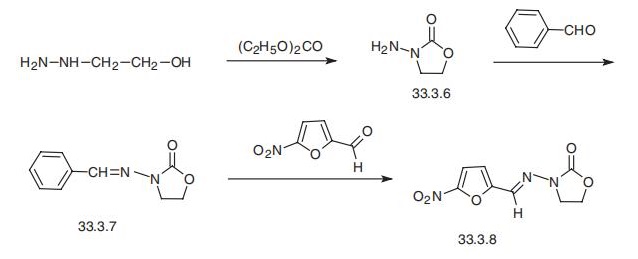
Veterinary Drugs and Treatments
Furazolidone is usually a drug of second choice in small animals to treat enteric infections caused by the organisms listed below. Because it is no longer commercially available (in the USA), it may be difficult to locate.
Properties of Furazolidone
| Melting point: | 254-256°C (dec.) |
| Boiling point: | 366.66°C (rough estimate) |
| Density | 1.5406 (rough estimate) |
| refractive index | 1.7180 (estimate) |
| Flash point: | 2 °C |
| storage temp. | Keep in dark place,Sealed in dry,Room Temperature |
| solubility | formic acid: soluble50mg/mL |
| pka | -1.98±0.20(Predicted) |
| form | powder |
| color | yellow |
| Sensitive | Light Sensitive |
| λmax | 365nm(DMSO)(lit.) |
| Merck | 14,4300 |
| BRN | 8317414 |
| Stability: | Stable. Combustible. Incompatible with strong oxidizing agents. |
| NIST Chemistry Reference | Furazolidone(67-45-8) |
| IARC | 3 (Vol. 31, Sup 7) 1987 |
| EPA Substance Registry System | Furazolidone (67-45-8) |
Safety information for Furazolidone
| Signal word | Warning |
| Pictogram(s) |
 Health Hazard GHS08 |
| GHS Hazard Statements |
H361:Reproductive toxicity |
| Precautionary Statement Codes |
P280:Wear protective gloves/protective clothing/eye protection/face protection. |
Computed Descriptors for Furazolidone
| InChIKey | PLHJDBGFXBMTGZ-UITAMQMPSA-N |
Furazolidone manufacturer
Moteraa Biotech
New Products
4,4-Difluoropiperidine hydrochloride tert-butyl 9-methoxy-3-azaspiro[5.5]undecane-3-carboxylate Indole Methyl Resin N-Isopropylurea N,N-Dicyclohexylcarbodiimide(DCC) MELDRUMS ACID 5-METHYLISOXAZOLE-4-CARBOXYLIC ACID Magnessium Bis glycinate Zinc ascorbate 1-bromo-2-butyne 2-acetamidophenol 9(10H)-anthracenone Erythrosin B, 4-Piperidinopiperidine 2-((4-morpholinophenylamino) (methylthio) methylene) malononitrile 2,4-dihydroxybenzaldehyde 3-(4-morpholinophenylamino)-5-amino-1H-pyrazole-4-carbonitrile Methyl 2-methylquinoline-6-carboxylate 2,6-dichloro-4-nitropyridine 4-Bromo-2-chlorobenzonitrile 2-(benzylamino)acetic acid hydrochloride 4-(tert-Butoxycarbonylamino)but- 2-ynoic acid 3,4-dihydro-2H-benzo[b][1,4]dioxepine 1-Phenyl-1-cycloprppanecarboxylicacidRelated products of tetrahydrofuran




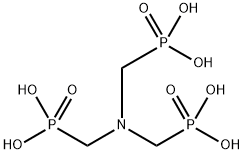



You may like
-
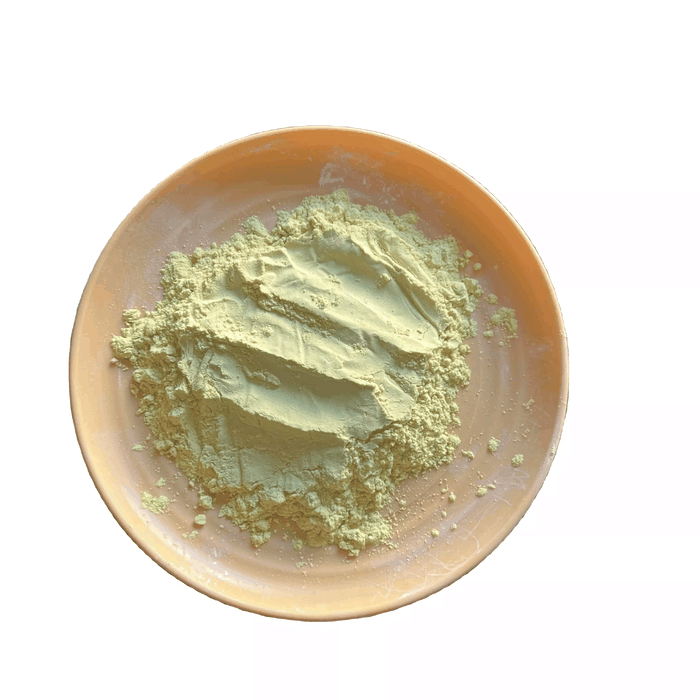 Furazolidone BP/USP 99%View Details
Furazolidone BP/USP 99%View Details -
 Furazolidone 99%View Details
Furazolidone 99%View Details -
 67-45-8 95-99%View Details
67-45-8 95-99%View Details
67-45-8 -
 Furazolidone 99% (HPLC) CAS 67-45-8View Details
Furazolidone 99% (HPLC) CAS 67-45-8View Details
67-45-8 -
 Furazolidone Powder Bp Usp Cas 67 45 8View Details
Furazolidone Powder Bp Usp Cas 67 45 8View Details
67-45-8 -
 Yellow Furazolidone Powder, Packaging Size: 25 KgView Details
Yellow Furazolidone Powder, Packaging Size: 25 KgView Details
67-45-8 -
 Furazolidone Powder BP USP CAS 67-45-8View Details
Furazolidone Powder BP USP CAS 67-45-8View Details
67-45-8 -
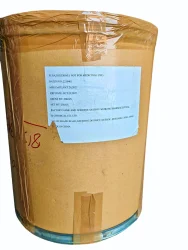 Powder As Recommended By Veterinarian Furazolidone, For Poultry And Aqua, Treatment: DiseasesView Details
Powder As Recommended By Veterinarian Furazolidone, For Poultry And Aqua, Treatment: DiseasesView Details
67-45-8
